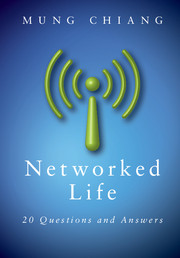Book contents
- Frontmatter
- Contents
- Preface
- Acknowledgements
- Roadmap
- 1 What makes CDMA work for my smartphone?
- 2 How does Google sell ad spaces?
- 3 How does Google rank webpages?
- 4 How does Netflix recommend movies?
- 5 When can I trust an average rating on Amazon?
- 6 Why does Wikipedia even work?
- 7 How do I viralize a YouTube video and tip a Groupon deal?
- 8 How do I influence people on Facebook and Twitter?
- 9 Can I really reach anyone in six steps?
- 10 Does the Internet have an Achilles' heel?
- 11 Why do AT&T and Verizon Wireless charge me $10 a GB?
- 12 How can I pay less for each GB?
- 13 How does traffic get through the Internet?
- 14 Why doesn't the Internet collapse under congestion?
- 15 How can Skype and Bit Torrent be free?
- 16 What's inside the cloud of iCloud?
- 17 IPTV and Netflix: How can the Internet support video?
- 18 Why is WiFi faster at home than at a hotspot?
- 19 Why am I getting only a few % of the advertised 4G speed?
- 20 Is it fair that my neighbor's iPad downloads faster?
- Index
- Notes
10 - Does the Internet have an Achilles' heel?
Published online by Cambridge University Press: 05 November 2012
- Frontmatter
- Contents
- Preface
- Acknowledgements
- Roadmap
- 1 What makes CDMA work for my smartphone?
- 2 How does Google sell ad spaces?
- 3 How does Google rank webpages?
- 4 How does Netflix recommend movies?
- 5 When can I trust an average rating on Amazon?
- 6 Why does Wikipedia even work?
- 7 How do I viralize a YouTube video and tip a Groupon deal?
- 8 How do I influence people on Facebook and Twitter?
- 9 Can I really reach anyone in six steps?
- 10 Does the Internet have an Achilles' heel?
- 11 Why do AT&T and Verizon Wireless charge me $10 a GB?
- 12 How can I pay less for each GB?
- 13 How does traffic get through the Internet?
- 14 Why doesn't the Internet collapse under congestion?
- 15 How can Skype and Bit Torrent be free?
- 16 What's inside the cloud of iCloud?
- 17 IPTV and Netflix: How can the Internet support video?
- 18 Why is WiFi faster at home than at a hotspot?
- 19 Why am I getting only a few % of the advertised 4G speed?
- 20 Is it fair that my neighbor's iPad downloads faster?
- Index
- Notes
Summary
A Short Answer
It does not.
A Long Answer
Power-law distribution and scale-free networks
Sure, the Internet has many security loopholes, from cyber-attack vulnerability to privacy-intrusion threats. But it does not have a few highly-connected routers in the center of the Internet that an attacker can destroy to disconnect the Internet, which would have fit the description of an “Achilles' heel”. So why would there be rumors that the Internet has an Achilles' heel?
The story started in the late 1990s with an inference result: the Internet topology exhibits a power-law distribution of node degrees. Here, the “topology” of the Internet may mean any of the following:
the graph of webpages connected by hyperlinks (like the one we mentioned in Chapter 3),
the graph of Autonomous Systems (ASs) connected by the physical and business relationships of peering (we will talk more about that in Chapter 13), and
the graph of routers connected by physical links (the focus of this chapter).
For the AS graph and the router graph, the actual distribution of the node degrees (think of the histogram of the degrees of all the nodes) is not clear due to measurement noise. For example, the AS graph data behind the power-law distribution had more than 50% of links missing. Internet exchange points further lead to many peering links among ASs.
- Type
- Chapter
- Information
- Networked Life20 Questions and Answers, pp. 214 - 234Publisher: Cambridge University PressPrint publication year: 2012



